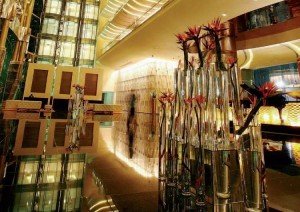By Carlo Wolff www.hotelnewsnow.com
DUBAI, United Arab Emirates—More than two years after a US$10 billion bailout from oil-rich neighbor Abu Dhabi pulled Dubai out of recession, the Dubai hotel market seems to be booming.

Twenty-seven new hotels are set to open this year, with another 12 on tap for 2013 and one property for 2014, according to the Emirate’s Department of Tourism and Commerce Marketing.
Among U.S. brands building in this tall, modern city of 2 million:
- Marriott International: The first 807-room tower of the 1,608-room JW Marriott Marquis Hotel Dubai on Sheikh Zayed Road, expected to be the world’s tallest hotel at 1,164 feet (355 meters), has a Q4 2012 opening date; next year, a 352-room Marriott is set to open in Dubai Health Care City, along with the 170-room JW Marriott Hotel Dubai Lifestyle City,
- Hilton Worldwide: The 559-room Conrad Dubai is scheduled to open in September; the Waldorf Astoria Dubai Palm Jumeirah, at 324 rooms, is scheduled to open in June 2014.
- While the DTCM says InterContinental Hotels Group was to open the 367-room Crowne Plaza Hotel Business Bay on Sheikh Zayed Road in December, an IHG spokesperson said mid-February that the hotel is not open “and the owners have not currently updated us with an opening date.”
- Starwood Hotels & Resorts Worldwide: the 330-room W Dubai Festival City, is set to open in summer 2013; and a 190-room Rosewood will open in December in the Dubai International Financial Center.
But U.S. brands aren’t the only ones capitalizing on this fast-growing marketplace. The German flag Mövenpick aims to open its 180-unit Residence the Square Dubai in the first quarter of 2012 in the Jumeirah district, along with a 324-room Oceana Hotel & Spa in the even classier Palm Jumeirah, a “frond” dredged from the Arabian Sea.
Other international players on this shopping-crazy United Arab Emirate’s lodging set: Meliá Hotels International, Jumeirah Hotels & Resorts, Fairmont Hotels & Resorts, Tiara Hotels & Resorts, Kempinski (whose residences on Palm Jumeirah are a reserved, relaxing respite from some of the more futuristic deluxe hotels in the city itself), and the Indian luxury brand Taj Hotels Resorts & Palaces.
There are 312 existing hotels comprising 62,357 rooms in the market, according to STR Global, sister company of HotelNewsNow.com.
Awash in luxury
Dubai already seems awash in luxury lodging, typified by two hotels this reporter stayed in during a visit there 28 November through 4 December: the 285-unit Meydan Hotel fronting on the Meydan Racecourse, which is outside the city, and the Shangri-La, a mature, relaxing business hotel on Sheikh Zayed Road, Dubai’s main drag.
Rack rates at the strikingly futuristic Meydan (the grandstand is a kilometer—almost one mile— long) range from AED2,700 (US$735) for a standard suite to AED30,000 (US$8,167) for the presidential suite. At the Shangri-La, deluxe room rates in the summer (a decidedly low season when temperatures can reach 140 degrees Fahrenheit) are AED600 (US$163), and AED1,350 (US$367) for a one-bedroom suite. In high season, the respective rates are AED900 (US$245) up to AED2,850 (US$776). One emirati dirham, the region’s currency, equals a little more than 27 cents.
The visit, sponsored by the Department of Tourism and Commerce Marketing, the government’s tourism promotion arm, also included inspections of several other luxury hotels including the recently opened and terminally sleek Armani Hotel in the Burj Khalifah, at more than half a mile high, it’s the world’s tallest building; the Ritz-Carlton Dubai Financial Centre; the Ibn Battuta Gate Hotel, a wildly creative Mövenpick structure honoring Ibn Battuta, a medieval celebrity who visited almost all of the Islamic world; the Habtoor Grand Resort & Spa, a sprawling beachfront property affording great views of stunt flying on 2 December, the 40th anniversary of the founding of the Emirates; the One&Only The Palm, a stunning resort on one of the Palm “fronds” featuring white sands, the requisite spa and sumptuous dining; the pyramid-themed, imposing, elegant Raffles Dubai; and the midscale Park Regis Kris Kin Hotel.
According to Abdullah Bin Suwaidan of the DTCM, there were 2.38 million hotel guests in Dubai in 2000. In 2010, there were 8.29 million, and visitations were up 10.9% in the first quarter of 2011. As of early December, Dubai boasted 573 hotels and hotel apartments, representing more than 72,000 rooms.
The country’s hotel industry posted impressive gains in dollar terms for the year end. Compared to 2010, Dubai’s occupancy increased 7%, average daily rate was up 3.4% and revenue per available room rose 10.7%, according to STR Global.
In 2008, the third terminal of Dubai International Airport opened, dedicated to Emirates Airlines. And in 2009, this tightly controlled Emirate launched the 55-station, two-line, 43 mile (70 kilometer) Dubai Metro, which Suwaidan called the largest automated metro in the world.
Thirty-five percent of the Dubai economy revolves around tourism. The recession postponed things, but it didn’t stop them, Suwaidan said. Marketing is key, he added. The time seems right.
As if to prove Suwaidan’s point, Inna Gernega, head of public relations at the Kempinski Hotel & Residences on Palm Jumeirah, said only a few of the residences remain unsold. Most went for US$2 million to US$8 million four years ago, she said. More info













